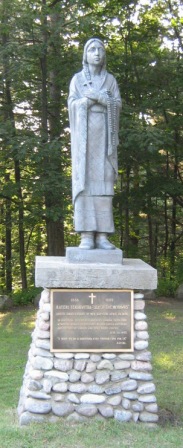Saint Kateri Tekakwitha

This statue of Saint Kateri Tekakwitha can be seen at the Martyrs Shrine in Canada
Montreal, Nov 11, 2012 (CNA).- Nov. 4 at St. Joseph's Oratory in Montreal, thanks was given for the canonization of Saint Kateri Tekakwitha.
Bishop Gendron was the main celebrant and homilist for the Mass that drew 2,500 people to the Oratory.
Several more Canadian bishops concelebrated the Mass, among them were Archbishop Paul-Andre Durocher of Gatineau; Archbishop Christian Lepine of Montreal; Bishop Jacques Berthelet, emeritus of Saint Jean-Longueuil; and Bishop Louis Dicaire, auxiliary of Saint Jean-Longueuil.
Also, representatives from the First Nations of Canada, the Canadian Catholic Aboriginal Council, and Kahnawake – the Canadian community where St. Kateri settled – participated in the Mass.
“As with Saint Kateri, let us be guided in all events by the Spirit … so that our lives may become a love story with Jesus,” Bishop Gendron said in his homily.
Bishop Gendron said the canonization was an important step in the process of reconciliation between the First Nations of Canada and Canadians of European descent.
Saint Kateri is prayed to by believers throughout the Americas and in parts of Europe, and celebrated every year at a festival in Fonda, N.Y., about 65 kilometres northwest of Albany, the state capital.
Kateri was born in 1656 in a Mohawk village near Fonda.
Her mother was Algonquin who was captured around Trois-Rivieres, Que. and was married to a Mohawk chief, according to Darren Bonaparte, a historian who recently published a book on Kateri's life titled The Mohawk Repatriation of Kateri Tekahkwitha.
She experienced war and pestilence at a young age. Her village was burned by the French in 1666. Her mother, father and younger brother all died during the smallpox epidemic of 1661-62.
She survived the disease, but it damaged her eyesight and left her face scarred. She remained weak throughout her life, shunning sunlight, emerging only covered with a shawl or a blanket, said Bonaparte, a Mohawk who lives in Akwesasne, a First Nation community about 100 kilometres southwest of Montreal.
She was baptized Catholic in 1676 and, after facing pressure from her uncle to give up Catholicism, was spirited away with the help of her brother-in-law and the Jesuits to the mission of St. Francois Xavier du Sault, in an area along the St. Lawrence River around what is now Kahnawake and Ville Sainte-Catherine.
There, Kateri found a Mohawk community in the midst of extreme religious fervour, said Bonaparte.
Bonaparte said Kateri, who took a vow of virginity and attempted to start her own convent, was swept up in the movement.
Her devotion likely killed her. Standing about 4 1/2 feet tall, Kateri frequently fasted, weakening her already frail body. She once scattered thorns on her bed and lay on them for three nights, Bonaparte said.
When she died, it was reported that her scarred face became beautiful, and that priests and friends saw her in visions, while miracles were attributed to her intercession. Her crucifix, pieces of her garments and the dirt from her grave were rumoured to have healing powers, said Bonaparte.
By Jorge Barrera, Canwest News Service August 13, 2009
© Copyright (c) Canwest News Service
Return from Saint Kateri to Saints
Home Page
